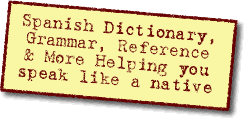Ask a Question(Create a thread) |
|
|||||||
TildeAsk about definitions or translations for Spanish or English words. |
 |
|
|
Thread Tools | Display Modes |
|
#11
|
|||
|
|||
|
The squiggle above the N or n.
Hello! Learn Spanish in Spain, I was taught that the squiggle above the ñ was called a Ñilde. Tilde, I was tought, was for the T, as in Tilde for T and Ñilde for the Ñ. Any profesional Spanish scholars out there that can verify this? Thank you and Happy New 2009!
|
|
Get rid of these ads by registering for a free Tomísimo account.
|
|
#12
|
||||
|
||||
|
Welcome to the forums!
The answer to your question was given in the earlier posts of this thread. You won't find Ñilde in the dictionary and there is no tilde (diacritical mark) on the letter T in the Spanish language. |
|
#13
|
||||
|
||||
|
Quote:

__________________
"When the first baby laughed for the first time, the laugh broke into a thousand pieces and they all went skipping about, and that was the beginning of fairies." from Peter Pan by J.M.Barrie   
|
|
#14
|
||||
|
||||
|
The eñe is something completely foreign to English speakers. To Spanish speakers the squiggle is part of a letter like to dot on the i or the cross of the t. Traditionally American Spanish teachers refer to that squiggle as the tilde that modifies the letter n the way the diarisis modifies the u. Perhaps it should be considered a separate letter instead of a modification of the n , but to my knowledge people haven't been taught that way.
__________________
Me ayuda si corrige mis errores. Gracias. |
|
#15
|
||||
|
||||
|
Quote:
Tilde is just one of the English words for the squiggley mark. We English speakers must have a name for it because that mark isn't used in English words. As Poli suggested, even though the letters of the alphabet are usually thought of as complete entities, we do have terms to describe the dot over the i, the legs of the k, the cross of the t, etc. Don't Spanish school teachers talk about the virgulilla, or tilde, sobre la ñ? |
 |
| Tags |
| accent mark, eñe, tilde |
«
Previous Thread
|
Next Thread
»
| Link to this thread | |
|
|
|||||||
 Similar Threads
Similar Threads
|
||||
| Thread | Thread Starter | Forum | Replies | Last Post |
| la tilde en solo (sólo) | sosia | Grammar | 9 | May 18, 2008 02:29 AM |
All times are GMT -6. The time now is 05:22 PM.









 Linear Mode
Linear Mode

